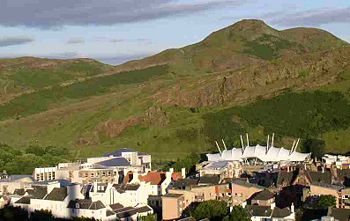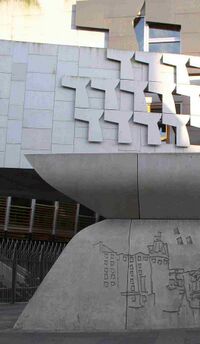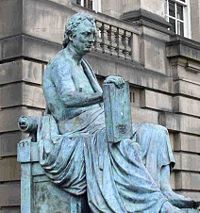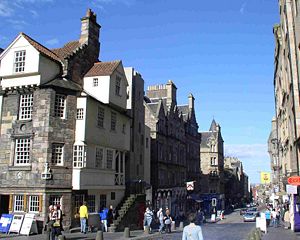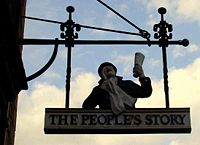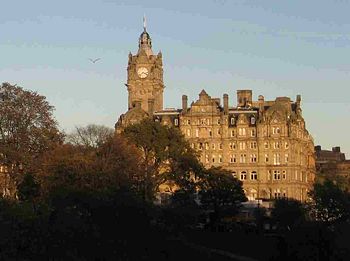Edinburgh
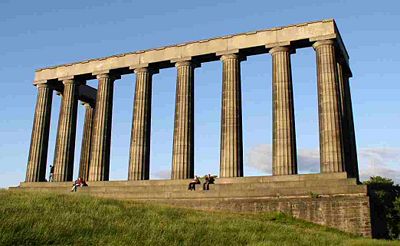
The National Monument to the Napoleonic Dead, on Calton Hill, Edinburgh, designed by Charles Robert Cockerell and William Henry Playfair, was modelled on the Parthenon in Athens. It is commonly believed that the monument was never finished, because the money for it ran out, and as a result, it has been called Edinburgh's Disgrace or Edinburgh's Folly. However, the unfinished look is exactly as the architects intended [1]‘the Modern Ruin’ as it has been called, an imposing object from far and near, and giving Edinburgh, even from the sea, that false air; of a Modern Athens which has earned for her so many slighting speeches. It was meant to be a National Monument; and its present state is a very suitable monument to certain national characteristics.Robert Louis Stevenson (1850-1894)
Edinburgh is the capital city of Scotland and home to the Scottish Parliament. In 2001, Edinburgh had a population of 448,624, and has since grown quite rapidly. Edinburgh hosts the Edinburgh International Festival every July, as well as the Fringe festival, the largest festival of performing arts in the world. It has some of the most famous tourist sites in Britain, including Edinburgh Castle, and attracts about 13 million tourists each year. Edinburgh's "Old Town" and "New Town" districts were listed as a UNESCO World Heritage Site in 1995. Edinburgh also hosts the Edinburgh Military Tattoo, the Edinburgh International Film Festival, as well as jazz, book and science festivals. Other notable events celebrated in Edinburgh include the Hogmanay street party (31 December), Burns Night (25 January), St. Andrew's Day (November 30), and the Beltane Fire Festival (30 April).
Origins
- "Never was there such a host
- From the fort of Eiddyn,
- That would scatter abroad the mounted ravagers." from translation of "Y Gododdin")
The city's name is thought to come from the Brythonic "Din Eidyn" (Fort of Eidyn) the name given to a hillfort and known from the earliest known British poem "Y Gododdin", attributed to Aneirin in about 600 CE. The poem describes warriors feasting in a great hall before setting out to die in a heroic battle against the Saxons from which none returned. Burh, meaning "fortress", is a translation of the Brythonic Din. The poem (as preserved) is written in Old or Early Medieval Welsh - the language of the region; Gaelic, commonly thought of as the native language of Scotland, was only ever generally spoken in the highlands and western isles of Scotland. The poem includes an early mention of Arthur, but only to mention that he was not one of the warriors, and this may have been a late insertion.
The Wealthy City
- "Here Wealth still swells the golden tide,
- As busy trade his labours plies;
- There Architecture's noble pride
- Bids elegance and splendour rise;
- Here justice, from her native skies
- High wields her balance and her rod;
- There Learning, with his eagle eyes,
- Seeks Science in her coy abode."
These lines are from "Address to Edinburgh" by Robert Burns (1759-1796), Scotland's most famous poet (who evidently was capable of flashes of mediocrity). Today, Edinburgh is still a wealthy city, with high property values and many millionaire residents[3]. It has the strongest economy of any city in the UK except London.[1] It is home to the Scottish Parliament, and the Scottish Executive, the Justiciary Office (which provides the administrative services for the High Court of Justiciary and the Court of Criminal Appeal), and the Royal Bank of Scotland Group (the second largest bank in Europe and the fifth largest in the world). The University of Edinburgh, founded in 1583, is one of the UK's leading universities, and Edinburgh also has two newer Universities, Heriot-Watt University, which began as a school for technical education of the working classes, and Napier University, a polytechnic that was given University status in 1992.
The Windy City
Edinburgh pays cruelly for her high seat in one of the vilest climates under heaven. She is liable to be beaten upon by all the winds that blow, to be drenched with rain, to be buried in cold sea fogs out of the east, and powdered with the snow as it comes flying southward from the Highland hills. The weather is raw and boisterous in winter, shifty and ungenial in summer, and a downright meteorological purgatory in the spring. The delicate die early... RL Stevenson
At the foot of Leith Walk, close to the St James shopping centre (whose design is a popular topic of critical comment), is a statue of Sherlock Holmes, commemorating his creator, Sir Arthur Conan Doyle, (1859-1930) a graduate of Edinburgh University. Although the Sherlock Holmes stories are set in London, the dark and dank fog-ridden atmosphere is thought to have had its inspiration in Edinburgh[4]. Edinburgh’s weather is at best unpredictable, but is generally cool or dank with a sharp wind. On cloudless days in Summer, when the wind dies down, a cold sea fog (known locally as a "haar") often descends on the city, a metereologically interesting phenomenon of temperature inversion. Edinburgh’s winters are mild, and differ mainly from the Summers in their much shorter daylength. Edinburgh is a city that is good for children in the sense that, for much of the year, there is little else to do in the evenings.
The Old Town
— skulking jail-birds; unkempt, bare-foot children; big-mouthed, robust women, in a sort of uniform of striped flannel petticoat and short tartan shawl; among these, a few supervising constables and a dismal sprinkling of mutineers and broken men from higher ranks in society, with some mark of better days upon them, like a brand. RL Stevensonon the inhabitants of the Old Town
Edinburgh in the 16th century was a walled city enclosing what is now the Old Town; little of the original walls remains, but the street plan of the Old Town is essentially that of the medieval city, and many of its buildings are extremely old. By the end of the 17th century, the relative safety of the city in a generally turbulent country had led it to become both relatively affluent and extremely overcrowded, with a population of about 60,000; bounded to the east by the sea, and to the north by a large lake that had become a large open sewer (the Nor’ Loch) it had little scope to expand. The author Daniel Defoe declared "I believe that in no city in the world so many people have so little room." The city lacked any adequate sanitation (chamber pots were emptied from windows above with the warning cry of Gardy loo! from the French, "Prenez garde a l'eau!"), and was nicknamed “Auld Reekie” after its distinctive smell. Its atmosphere and its large population of prostitutes, itinerants and thieves eventually encouraged its wealthy burghers to plot to abandon the city for a “New Town”, to be built on the fields north of the Nor' Loch.
Today the Old Town is a thriving and diverse area. It includes a gay area (known locally as the “pink triangle”); the televised comments of American evangelist Pat Robertson "In Scotland, you can't believe how strong the homosexuals are. It's just simply unbelievable," [5] became for a while a polular slogan on T-shirts in the city. It also includes an area of sex clubs and shops (the “pubic triangle”).
The New Town
Firm ideas for a New Town emerged after the suppression of the 1745 Jacobite Rising cumulating in the Battle of Culloden in 1746; in 1746 the City of Edinburgh held a competition, won by 21-year-old architect James Craig, whose initial idea of a ‘patriotic’ street plan in the shape of a Union Jack, developed into a plan for a grid-iron system with 3 main streets - Princes Street, George Street and Queen Street running North-South with the two large, formal squares at either end - St Andrew's Square and St George's Square, renamed Charlotte Square after King George's wife, Queen Charlotte, in 1785.
Thus the Nor’ Loch was drained in 1759, to become what is now Princes Street Gardens, and in 1790 an earthen causeway across the bed of the lake was built (The “Mound”) to connect the Old Town with the new development. The New Town, the first “planned city” development in the world, is now a World Heritage site ; its combination of Gothic and Greek architectural styles aimed to establish Edinburgh as the “Athens of the North.” Its stone residential buildings generally house four floors of apartments, one below street level; the rooms are spacious, high ceilinged and elegant, and now, as then, are very expensive. The architect for many of the most famous buildings was Robert Adam, who designed Register House, (built from 1773 onwards) and Charlottte Square (built in 1791).
The main commercial street of the New Town, Princes Street, runs from The Balmoral Hotel (opened in 1902 as the north British Hotel) in the east to the Caledonian Hotel (opened in 1903) in the west. The street was originally named St Giles Street after the patron saint of Edinburgh, and was renamed Princes Street after King George III’s sons (Prince George, the future George IV, and the Duke of York). Few of the buildings on Princes Street itself are particularly noteworthy, but an exception is the Department Store "Jenners" (opened as "Kennington & Jenner" in 1838), an old Edinburgh institution. Almost the whole premises of Jenners were destroyed by fire on 26 November 1892, and architect William Hamilton Beattie was commissioned to create a new building, built in the Renaissance style using pink sandstone and lavishly decorated. Jenners was the oldest independent department store in the world until 2005, when it was bought by the House of Fraser.
Princes Street is developed only on its south facing side, overlooking the Gardens and facing the Old Town, which was abandoned to the prostitutes, the poor, and the generally undeserving elements. On the Mound stand the National Gallery of Scotland and the National Exhibition Centre, two imposing buildings that expressed the cultural pretensions of the Edinburgh elite.
At Hogmanay (the New Year), Edinburgh surrenders itself to an excess of drinking and merrymaking with a large street party on Princes Street. In the rest of the UK January 1st is a national holiday, in Scotland, January 2nd is also a holiday, to enable its citizens to recover.
In holiday seasons, busking bagpipers in kilts accept money from tourists on Princes Street, possibly offered in an effort to make them stop playing. The bagpipes is an instrument best played a great distance; once played by clan warriors amassing for battle to inspire fear and trepidation in the enemy, bagpipes were outlawed as instruments of war after the defeat of Bonnie Prince Charlie in 1745. Lately, the pipes have been adapted to the nostalgic and sentimental tastes of expatriate Scots. However, the sounds of a lone bagpiper playing on the Castle battlements at the end of each performance of the Edinburgh Military Tattoo are a fond memory for many visitors to Edinburgh, even those cynics who watched in the hope that he might fall off.
The Royal Mile
The Royal Mile is the main street in Edinburgh's Old Town, and runs from Edinburgh Castle to the Royal Palace of Holyrood, a distance of just over a mile. The New Scottish Parliament building is at the foot of the Royal Mile, opposite the Palace. St Giles' Cathedral, the High Kirk of Edinburgh, is in Parliament Square on the Royal Mile; its four main pillars are dated to 1190.
Just outside the kirk, inset into the pavement is a cobblestone mosaic in the shape of a heart - the "Heart of Midlothian", that marked the entrance to Edinburgh's 15th century tolbooth. Originally an office for collecting tolls, the tolbooth became a prison, with a scaffold outside. Traditionally, prisoners would spit on the door of the tolbooth and this tradition is still preserved as the custom of spitting on the Heart of Midlothian. Amongst those publicly hanged there is Thomas Aikenhead (c. 1678 - 1697), a student who was the last person in Britain to be executed for blasphemy. The indictment read:
... the prisoner had repeatedly maintained... that theology was a rhapsody of ill-invented nonsense, patched up partly of the moral doctrines of philosophers, and partly of poetical fictions and extravagant chimeras...That the Holy Scriptures were stuffed with such madness, nonsense, and contradictions, that he admired the stupidity of the world in being so long deluded by them...from the indictment of Thomas Aikenhead
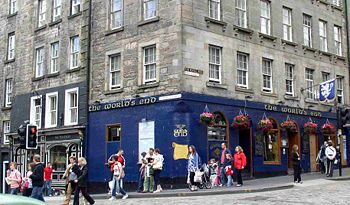
The World's End public house was the site of the last reported sighting of two young women, murdered in 1977. In 2007, a convicted killer and sex offender was brought to trial on DNA evidence, but the trial collapsed amidst controversy[2]
Deacon Brodie's Tavern on the Royal Mile perpetuates the memory of Deacon William Brodie (?-1788). Brodie led a double life; he was a qualified wood-worker and a pillar of the community who is known to have met Robert Burns and the painter Sir Henry Raeburn, but also a heavy gambler with five illegitimate children. He began to take wax impressions of the keys to the houses in which he was working, later returning at night to rob them. His double life is said to have been the inspiration for Robert Louis Stevenson's story of "Dr Jekyll and Mr Hyde"
The Royal Mile contains entrances to many small alleys and closes, with picturesque names and often interesting histories. Mary King Close was one such Close. In 1753, development of a new building, the Royal Exchange (designed by John Adam) on the Royal Mile involved building over Mary King Close. The Royal Exchange is now the City Chambers – the administrative centre of the City, and what was once the street level of Mary King Close remained intact, though now completely overbuilt. The Close was forgotten, until in 1928 a council workman discovered an entrance to it. The Close is now open to visitors and is a major tourist attraction, encouraged by convenient tales of haunting.
John Knox House on the Royal Mile is a town house, built before 1490, that displays exhibits about John Knox, a Protestant leader born between 1505 and 1515, who died at Edinburgh on 24 November, 1572. John Knox is a controversial figure in Scotland's history, who was appointed minister of the Church of St. Giles' when the Reformed Protestant religion was ratified by law in Scotland in 1560. His “History of the Reformation” marks him as a leading figure in the Scottish reformation. He was outspoken in his attacks on the Catholic clergy of Scotland, accusing them of being "gluttons, wantons and licentious revelers." The distaste was mutual; according to the Catholic Encyclopedia [6], "permeated with the spirit of the Old Testament and with the gloomy austerity of the ancient prophets, [Knox] displays neither in his voluminous writings nor in the record of his public acts the slightest recognition of the teachings of the Gospel, or of the gentle, mild, and forgiving character of the Christian dispensation."
Suburbs
Edinburgh has a port, Leith. An active port for at least a thousand years, Leith was recently a disreputable area with a multitude of abandoned warehouses, unsavoury pubs and a thriving red-light district, and was the setting for the novel "Trainspotting" by Irvine Welsh that featured a cast of heroin addicts. In 1986, Edinburgh was labelled as the AIDS capital of Europe, because of the relatively high incidence of HIV spread by intravenous drug users, though this accolade is probably undeserved (possibly belonging to Barcelona [7]). Leith is now largely gentrified, housing the Scottish Executive and an extensive coastal regeneration development has swept away many of the traces of its former character.
Edinburgh also has a gently decaying seaside area, Portobello: a resort area in days when travel to sunnier climes was unaffordable or foreign food suspected. The first bathing machines were reported at Portobello in 1795, and a pier with a camera obscura was built in 1871, designed by Thomas Bouch, designer of the ill-fated Tay Railway Bridge. The pier is long gone. Just beyond Portobello is Musselburgh, home to one of the more unlikely and little used race courses in the UK, first opened in 1816.
Arthur's Seat
- Then, as for Arthur's Seat, I'm sure it is a treat
- Most worthy to be seen, with its rugged rocks and pastures green,
- And the sheep browsing on its sides
- To and fro, with slow-paced strides
(from "Edinburgh" by William McGonagall (1825-1902), either Scotland's worst poet, or a satirist of unrecognized genius)
In the centre of Edinburgh, enclosed within Holyrood Park (which is adjacent to the Royal Palace of Holyrood) is Arthur's Seat, the basalt lava plug of a long extinct volcano, last active around 335 million years ago, during the Carboniferous period. The hill rises to a height of 251 m (823 feet), and overlooks Edinburgh's Old Town to the West.
Two stony banks on the east side of Arthur's Seat are the remains of an Iron Age hill-fort. In 1836, seventeen tiny wooden coffins each containing a carved figure were found in a small cave just below the summit. It has been suggested that they may have associations with witchcraft or that they were intended as memorials to the victims of William Burke (1792-1829) and William Hare (1904-ca 1860), who sold bodies for dissection to the anatomist Professor Robert Knox of the Edinburgh Medical College, and turned to murder to satisfy the demand[8]. Burke and Hare murdered at least 16 people and perhaps as many as 30. Burke was hanged on 28th January 1828 (Hare escaped execution by givinig evidence against Burke), and his body was donated to the medical school to be dissected. A pocket-book made from his skin is on display in the Surgeon's Hall Museum of the Royal College of Surgeons of Edinburgh[9], and his skeleton is displayed at the Anatomy Resource Centre of the University of Edinburgh[10].
The Scottish Parliament
- "There is hope in honest error; None in the icy perfections of the mere stylist"
- Charles Rennie Mackintosh (1868-1928), quoted on the wall of the New Parliament Building
When the Scotland Act 1998 was passed by the UK Parliament, it led to the establishment of the first Scottish Parliament since 1707. In 1999, the first members of the new Scottish Parliament were elected. At first, the new Parliament met at the Assembly Hall at the top of The Mound. However, a new building was deemed necessary, and the chosen site was in Holyrood, opposite to the Royal Palace of Holyroodhouse but in an otherwise relatively depressed area of the city. The design for the new Parliament was opened to competition, won by a team led by Spanish architect Enric Miralles. Inspired by the surrounding landscape, the flower paintings of Charles Rennie Mackintosh and "upturned boats on the seashore", Miralles developed a design that he said was a building "growing out of the land"[11]. Over the course of the building project, costs escalated from an initial estimate of £40 million to a final cost of over £420 million, an increase that did not altogether escape comment. The building has won many architectural awards, and attracts strong opinions for and against ("Every day that passes reveals some new and unexpected detail of Miralles's posthumous masterpiece. Here, an extraordinary courtyard, there, a wall with windows like you have never seen before. It is hard to make sense of such an original design."[12]). The interior is generally thought well of, and viewed from above it is spectacular, but many dislike the exterior appearance from ground level. That appearance that is not markedly embellished by the concrete bollards and large concrete, blast-proof walls that were a late addition to parts of the building, prompted by fears of terrorist attacks.
Edinburgh's Churches
St Giles' Cathedral on the Royal Mile is the historic City Church of Edinburgh, founded in the 1120's and named after the patron saint of Edinburgh (a 7th century hermit who lived in France). Also known as the High Kirk of Edinburgh, St Giles' is the "Mother Church" of Presbyterianism and contains the Chapel of the Order of the Thistle (Scotland's chivalric company of knights headed by the Queen). St Giles' has a notable collection of stained glass windows dating from the 1870s onwards, one of the most beautiful of which was designed by Edward Burne-Jones, and made in the workshops of William Morris.
Edinburgh has many other imposing churches and, like all of the UK, few church-goers ("The Edinburgh University was a great cultural centre of theology. I don't know, we need to pray for them..." - Pat Robertson). Some of its churches have been put to alternative use; Frankenstein’s on George IV street is a wine bar in an 18th century Pentecostal church building of strikingly Gothic design. The "New North Free Church" on Bristow Place is now the Bedlam Theatre, a student-run theatre and late-night improvisational comedy venue during the Fringe Festival. The theatre is named after the Bedlam madhouse, which was attached to the Edinburgh Charity Workhouse behind nearby Teviot Place [13].
Famous Residents
Edinburgh is home to novelists JK Rowling, Ian Rankin and Alexander McCall-Smith who is a professor of Medical Law at the University of Edinburgh. JK Rowling began her saga of boy wizard Harry Potter as a single mother, living on benefits, often writing in Edinburgh coffee houses (including the Elephant House on George IV bridge) to save money on heating. Ian Rankin’s novels portray Edinburgh as a dark place of corrupt politicians, small-time gangsters, seedy bars, vandal-ridden housing estates and drug-dealers, in marked contrast to McCall-Smith’s elegant and polite portrayal of a genteel city of middle class affectations.
Edinburgh was also a center of the Scottish Enlightenment, home to many great thinkers including David Hume (1711-17716) who according to RL Stevenson, "ruined Philosophy and Faith"[14], and Adam Smith (1723-1790), the author of The Wealth of Nations. Hume has a statue on the Royal Mile, and one for Smith is planned[15]. Alexander Graham Bell, the telephone pioneer, was born in Edinburgh, as were:
- James Hutton (1726-1797), the "Father of Geology" whose theory of Uniformitarianism provided an explanation of the geological history of the earth, which had "no vestige of a beginning, no concept of an end".
- James Clerk Maxwell (1831-1879) who contributed significantly to the study of electro-magnetism and prepared the way for quantum physics, and is regarded as one of the world's greatest physicists.
- John Napier (1550-1617), a mathematician mainly remembered for the invention of logarithms and the decimal point.
- William Topaz McGonagall (1830-1902), widely regarded as "The World's Worst Poet"
- Muriel Spark (1918-2006), novelist. The central character of her best-known novel "The Prime of Miss Jean Brodie", which is set in an Edinburgh girls school, is a feminist who admires Mussolini, Franco, and Hitler.
Sir Walter Scott (1771-1832) was educated at the Old High School in Edinburgh, and Tony Blair at Fettes College. The writer and critic Thomas Carlyle (1795-1881) became rector of Edinburgh University in 1866. Adam Ferguson (1723-1816), who was a Professor of Moral Philosophy at Edinburgh is father of "Sociology".
Museums and Galleries
- the Palace of Holyroodhouse, founded as a monastery in 1128, is The Queen's official residence in Scotland. Mary, Queen of Scots lived here between 1561 and 1567. Today, the Palace is the setting for State ceremonies and official entertaining, and is open to the public when the Queen is not in residence there. Adjacent to the Palace, the Queens Gallery displays exhibitions of art from the Royal Collection.
- Edinburgh CastleOne of the UK's leading tourist attractions, the Castle's features include St Margaret's Chapel - Edinburgh's oldest building, dating from the 1100s; Crown Square - the main courtyard, developed in the 15th century; The Great Hall with a hammerbeam roof built by James IV; The Half Moon Battery, from the late 16th century; and The Scottish National War Memorial added after the First World War. The Edinburgh Military Tattoo is held every Summer in the esplanade outside the Castle.
- The City of Edinburgh Museums and Galleries Includes information on The Museum of Childhood and The Writers' Museum.
- The National galleries of Scotland
- National Museum of Scotland Chambers' Street
- National War Museum at Edinburgh Castle
- National Museums Collection Centre Granton
- Surgeons' Hall Museums Royal College of Surgeons of Edinburgh, Nicolson Street
- City Art Centre Holds the City's collection of Scottish Art, and hosts temporary exhibitions.
- Georgian House at 7 Charlotte Square. Owned by the National Trust for Scotland. One of Robert Adam's designs for Charlotte Square, considered a masterpiece of urban architecture, and now restored as a typical 1790-1810 mansion. China, silver, paintings and furniture are on display.
- Gladstone’s Land, in the Lawnmarket, Royal Mile. Owned by the National Trust for Scotland, this is the 17th century tenement home of an affluent merchant.
- John Knox House
- The Leith Gallery Scottish contemporary art
- Royal Botanic Gardens founded in 1670 and moved to its present location in Inverleith in 1820.
- [16] Designed by William Playfair, this is one of the finest galleries in Britain, containing works by Tintoretto, Titian, Poussin, Claude Lorraine, Rembrandt, Reynolds, Gainsborough, Chardin, Antonio Canova and Turner, as well as French Impressionists, and Scottish artists.
- Lady Stair’s House/Writer’s Museum on the Royal Mile, displays manuscripts, relics and memorabilia of Robert Burns, Sir Walter Scott and R.L. Stevenson.
- The Fruitmarket Gallery Changing international exhibitions of contemporary art, in the former Fruit Market south of Waverley Station in the center of Edinburgh.
- The Museum of Edinburgh, formerly known as Huntly House, occupies 16th and 17th century buildings in the heart of the Old Town. Exhibits include:the feeding bowl and collar belonging to Greyfriars Bobby; the National Covenant, the petition for religious freedom signed by Scotland’s Presbyterians in 1638; and the original plans for Edinburgh’s New Town drawn by architect James Craig.
- The Museum of Childhood on the Royal Mile, displays toys, costumes, books, dolls and games.
- National Portrait Gallery Queen St.
- The People's Story is housed in the late 16th century Canongate Tolbooth opposite the Museum of Edinburgh, on The Royal Mile. ' The People's Story ' uses oral history, reminiscence, and written sources to tell the story of the lives, work and leisure of the ordinary people of Edinburgh, from the late 18th century to the present.
- Mary King Close
Tourist attractions
- Dynamic EarthVisitor attraction run by a charitable trust committed to the education and lifelong learning of Earth sciences
- The Scott Monument on Princes St. is a 200 ft. high neo-Gothic spire commemorating the poet and novelist Sir Walter Scott(1771-1832) with 64 statuettes of Scott's novels' characters. Four viewing platforms (287 steps by narrow stairs to the top) allow dramatic views of Edinburgh. Scott's novels were enormously popular in the early 19th century, and he is said by some modern scholars to have had a seminal influence on the development of the European novel genre, but his popularity with readers had declined markedly by the end of the 19th century and never recovered.
- Scotch Whisky Heritage Centre on the Royal Mile is an exhibition about the whisky making process.
- Nelson's Monument at Calton Hill is a 106 ft. tall, tiered, circular tower with viewing gallery overlooking the city. It commemorates Admiral Lord Nelson's victory and death at the battle of Trafalgar on 21 October 1805.
- The Royal Yacht Britannia is moored at Ocean Terminal, Leith.
- The Edinburgh Dungeon is one of Edinburgh’s more unpleasant tourist “attractions”, displaying instruments of torture, and relating tales of horror and cruelty with gleeful prurience and a cavalier disregard for historical veracity.
- Edinburgh Zoo, opened in 1913
Hotels
- The George
- The Balmoral Hotel, at the east end of Princes Street
- The Caledonian Hotel, at the west end of Princes Street
- ↑ Edinburgh City Council. Major Development Projects 2006. Retrieved on 2007-04-21.



